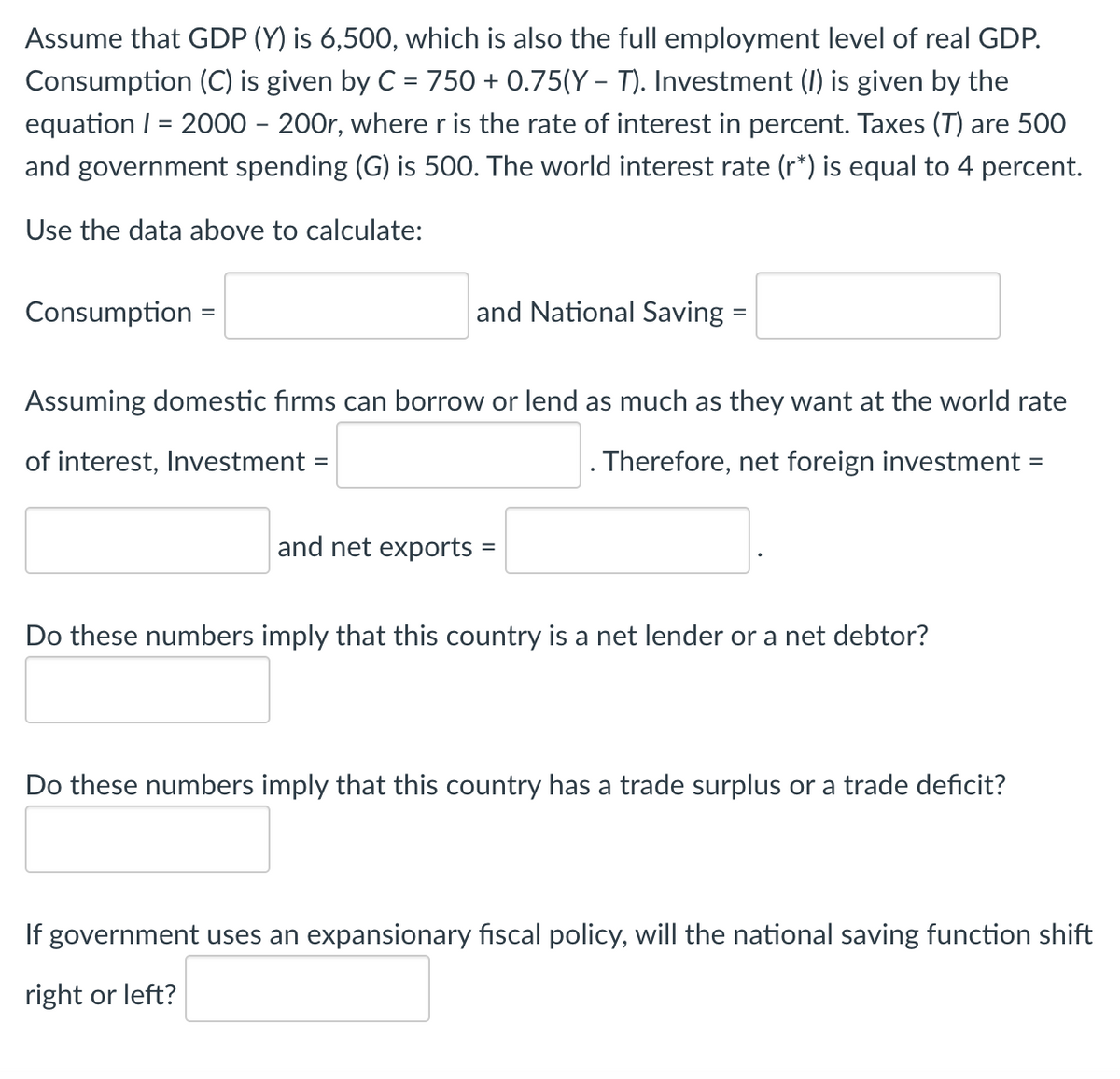Assume that GDP (Y) is 6,500, which is also the full employment level of real GDP. Consumption (C) is given by C = 750 + 0.75(Y – T). Investment (I) is given by the equation I = 2000 – 200r, whereris the rate of interest in percent. Taxes (T) are 500 and government spending (G) is 500. The world interest rate (r*) is equal to 4 percent. Use the data above to calculate: Consumption and National Saving Assuming domestic firms can borrow or lend as much as they want at the world rate of interest, Investment = Therefore, net foreign investment = and net exports : %3D Do these numbers imply that this country is a net lender or a net debtor? Do these numbers imply that this country has a trade surplus or a trade deficit? If government uses an expansionary fiscal policy, will the national saving function shift right or left?
Assume that GDP (Y) is 6,500, which is also the full employment level of real GDP. Consumption (C) is given by C = 750 + 0.75(Y – T). Investment (I) is given by the equation I = 2000 – 200r, whereris the rate of interest in percent. Taxes (T) are 500 and government spending (G) is 500. The world interest rate (r*) is equal to 4 percent. Use the data above to calculate: Consumption and National Saving Assuming domestic firms can borrow or lend as much as they want at the world rate of interest, Investment = Therefore, net foreign investment = and net exports : %3D Do these numbers imply that this country is a net lender or a net debtor? Do these numbers imply that this country has a trade surplus or a trade deficit? If government uses an expansionary fiscal policy, will the national saving function shift right or left?
Chapter8: The Keynesian Model
Section: Chapter Questions
Problem 20SQ
Related questions
Question

Transcribed Image Text:Assume that GDP (Y) is 6,500, which is also the full employment level of real GDP.
Consumption (C) is given by C = 750 + 0.75(Y – T). Investment (I) is given by the
equation I = 2000 – 200r, where r is the rate of interest in percent. Taxes (T) are 500
and government spending (G) is 500. The world interest rate (r*) is equal to 4 percent.
Use the data above to calculate:
Consumption
and National Saving=
Assuming domestic firms can borrow or lend as much as they want at the world rate
of interest, Investment =
Therefore, net foreign investment =
%3D
%3D
and net exports =
Do these numbers imply that this country is a net lender or a net debtor?
Do these numbers imply that this country has a trade surplus or a trade deficit?
If government uses an expansionary fiscal policy, will the national saving function shift
right or left?
Expert Solution
This question has been solved!
Explore an expertly crafted, step-by-step solution for a thorough understanding of key concepts.
Step by step
Solved in 4 steps

Knowledge Booster
Learn more about
Need a deep-dive on the concept behind this application? Look no further. Learn more about this topic, economics and related others by exploring similar questions and additional content below.Recommended textbooks for you


Economics: Private and Public Choice (MindTap Cou…
Economics
ISBN:
9781305506725
Author:
James D. Gwartney, Richard L. Stroup, Russell S. Sobel, David A. Macpherson
Publisher:
Cengage Learning

Macroeconomics: Private and Public Choice (MindTa…
Economics
ISBN:
9781305506756
Author:
James D. Gwartney, Richard L. Stroup, Russell S. Sobel, David A. Macpherson
Publisher:
Cengage Learning


Economics: Private and Public Choice (MindTap Cou…
Economics
ISBN:
9781305506725
Author:
James D. Gwartney, Richard L. Stroup, Russell S. Sobel, David A. Macpherson
Publisher:
Cengage Learning

Macroeconomics: Private and Public Choice (MindTa…
Economics
ISBN:
9781305506756
Author:
James D. Gwartney, Richard L. Stroup, Russell S. Sobel, David A. Macpherson
Publisher:
Cengage Learning


Microeconomics: Private and Public Choice (MindTa…
Economics
ISBN:
9781305506893
Author:
James D. Gwartney, Richard L. Stroup, Russell S. Sobel, David A. Macpherson
Publisher:
Cengage Learning